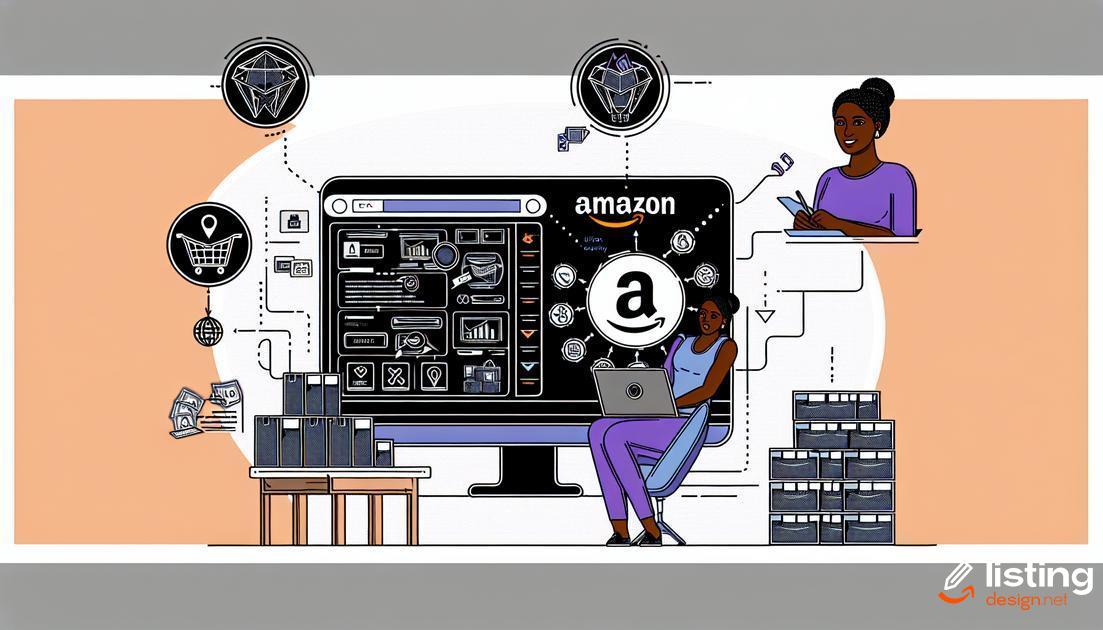Learning how to sell on Amazon without inventory can be a game-changer for aspiring entrepreneurs. This approach not only minimizes risk but also eliminates the need for hefty upfront investments. In this guide, we will delve into effective strategies and essential tips to help you succeed on Amazon without the burden of managing physical stock. Whether you are a beginner or looking to expand your e-commerce business, our roadmap will provide you with valuable insights.
Table of Contents
Understanding the Drop Shipping Model
Drop shipping is a retail fulfillment method where a store doesn’t keep the products it sells in stock. Instead, when a store sells a product, it purchases the item from a third party and has it shipped directly to the customer. As a result, the merchant never handles the product. This model significantly reduces the need for upfront investment in inventory, making it an attractive option for new Amazon sellers.
One of the key benefits of drop shipping is its simplicity and low risk. You can list a wide range of products on Amazon without purchasing them first. This eliminates the risk associated with unsold inventory and allows you to test different products easily. Additionally, it frees up your capital to invest in other areas of your business, such as marketing or customer service.
However, drop shipping also comes with its challenges. Finding reliable suppliers is crucial to ensure product quality and timely shipments. You must establish clear communication with suppliers and set expectations regarding processing and shipping times to avoid negative customer feedback. Another challenge is thin profit margins, as competition can drive prices down. It’s important to carefully calculate all costs involved and price your products competitively while ensuring profitability.
Given these factors, it’s crucial to thoroughly understand the drop shipping model before diving in. Although it offers an appealing route to selling on Amazon without inventory, success requires careful planning, strategic supplier relationships, and ongoing market analysis.
Finding Reliable Suppliers

Finding reliable suppliers is crucial for maintaining a successful drop shipping business on Amazon. You need to ensure that the suppliers you choose are dependable, offer quality products, and can handle orders efficiently.
Research Thoroughly: Start by researching suppliers on platforms like Alibaba, AliExpress, and other wholesale directories. Look for reviews, ratings, and testimonials from other sellers.
Contact Multiple Suppliers: Don’t just settle on the first one you find. Contact various suppliers to compare prices, shipping times, and return policies. This will give you a better understanding of what each has to offer.
Request Samples: Before you commit to a supplier, request samples of the products you intend to sell. This helps you assess the quality and ensure it meets your standards.
Check for Certification: Verify if the suppliers have necessary certifications and compliance with industry standards. This adds an extra layer of reliability and trust.
Establish Clear Communication: Ensure there is a clear line of communication with your suppliers. Miscommunications can lead to errors in order fulfillment or product specifications.
Analyze Their Delivery Performance: Evaluate the supplier’s track record for timely deliveries. Late shipments can negatively affect your seller ratings on Amazon.
Scalability: Choose suppliers who can scale with your business. As your order volume increases, they should be able to keep up without compromising on quality or delivery times.
By carefully selecting reliable suppliers, you can avoid many common pitfalls in the drop shipping model and build a sustainable and profitable business on Amazon.
Setting Up Your Amazon Seller Account
Why You Need an Amazon Seller Account
Setting up your Amazon Seller Account is crucial for anyone looking to start a business without holding inventory. With this account, you gain access to the platform’s extensive customer base, tools, and resources to succeed.
Creating Your Amazon Seller Account
Begin by visiting the Amazon Seller Central website. Click on the ‘Sign Up’ button and choose between an Individual Seller Account or a Professional Seller Account. While the Individual account is free, the Professional account comes with a monthly subscription fee but offers additional benefits.
During the registration process, you’ll need to provide several pieces of information, including:
- Business Name
- Address
- Contact Information
- Tax Identification Number
- Bank Account Details
This information helps Amazon verify your identity and ensures that you get paid correctly.
Verification Process
Once you’ve entered all the necessary details, Amazon will review your application. This might involve identity verification through the submission of documents like a passport or driver’s license. This step is crucial to avoid future complications and to ensure that your seller account is in good standing.
Account Customization
After your account is verified, you can customize your seller profile. This includes adding a profile picture, a detailed description of your business, and other relevant information to build trust with potential buyers.
Navigation and Tools
Familiarize yourself with the Amazon Seller Central dashboard. This is where you’ll manage product listings, track inventory, monitor sales performance, handle customer service, and much more. The more comfortable you are with this dashboard, the easier it will be to manage your business efficiently.
Setting up your Amazon Seller Account correctly is the first step toward a successful drop-shipping business. It provides the foundation upon which you can build and grow your e-commerce venture.
Creating Compelling Product Listings

To create compelling product listings on Amazon, it’s essential to focus on presenting clear, accurate, and attractive information about your products. Begin by crafting a captivating title that includes relevant keywords and describes the main features and benefits of the product. Make sure the title is concise yet informative.
Next, utilize high-quality images that showcase your product from different angles and highlight key features. A well-captured image can significantly boost customer interest and drive sales. Include zoomable images and videos when possible to provide a more detailed view of the product.
The bullet points section should summarize the most important aspects of the product. Focus on the benefits and unique selling points. Use clear and straightforward language to make the information easy to digest.
Writing a detailed product description is also crucial. This section should cover all product details that weren’t included in the bullet points. Incorporate keywords naturally to enhance search visibility. Highlight product specifications, usage instructions, and advantages in a manner that answers common customer questions.
Customer reviews can greatly influence buying decisions. Encourage satisfied customers to leave positive reviews and monitor this feedback regularly. Addressing negative reviews promptly and professionally shows potential buyers that you care about their satisfaction.
Lastly, optimize your product listing by including relevant backend keywords, which help Amazon’s algorithm display your product to the right audience. Consistently updating and refining your listings based on performance data can help keep your product competitive in the marketplace.
Managing Customer Orders
Effectively managing customer orders is crucial for success when selling on Amazon without holding inventory. Once a customer places an order on your Amazon store, immediately notify your supplier to ensure a prompt processing. This minimizes delays and keeps customers satisfied with swift shipping times.
It’s important to regularly track order statuses and maintain communication with both your supplier and the customer. Use Amazon’s Seller Central to monitor orders and respond to any customer inquiries. Providing accurate and timely updates to customers builds trust and encourages repeat business.
Automating Order Management
Integrating order management software can significantly streamline the process. These tools can automatically transfer order details to suppliers, reducing manual errors and saving time.
Handling Delayed or Lost Orders
Despite best efforts, delays or losses can occur. In such cases, clear and honest communication with customers is paramount. Quickly contact your supplier to resolve the issue and, if necessary, offer a replacement or refund to maintain customer satisfaction.
By focusing on efficient order management, handling issues promptly, and leveraging automation tools, you can ensure a smooth transaction experience, ultimately bolstering your business’s reputation on Amazon.
Handling Returns and Refunds

Handling returns and refunds can be a critical aspect when selling on Amazon without inventory. As a seller leveraging the drop shipping model, you need to understand the policies and procedures for returns and refunds set by both Amazon and your suppliers.
Firstly, communicate clearly with your suppliers about their return and refund policies. Ensure that they align with Amazon’s guidelines to avoid any discrepancies and potential customer dissatisfaction. Ensure your supplier’s return policy includes the time frame for returns, conditions under which returns are accepted, and who bears the shipping costs. This information should be transparent and easy for your customers to access.
Amazon’s return policies are customer friendly, aiming to build trust and loyalty. A critical part of your customer service strategy will be to handle returns efficiently. Always aim to process refunds as quickly as possible after receiving and inspecting the returned items. This helps in maintaining a positive seller rating and customer satisfaction.
Implement a clear and easy-to-understand return policy in your Amazon store listing. This should include instructions for initiating a return, acceptable reasons for returns, and any exceptions. Consistency in communication and execution is key to managing returns effectively.
If your supplier rejects a return request, it is essential to have contingency plans. These plans may include refunding the customer from your side or offering a replacement product. Handling these situations gracefully impacts the overall customer experience.
To minimize returns, focus on creating accurate and detailed product listings. Include high-quality images, comprehensive descriptions, and correct specifications. This approach helps in setting the right expectations and reduces the likelihood of customer dissatisfaction that leads to returns.
Marketing Strategies for Amazon Sellers
Optimizing Product Listings: Ensure your product listings are optimized for search. Use relevant keywords in the title, bullet points, and product descriptions. This will improve your visibility in Amazon’s search results and attract more customers.
Sponsored Products: Leverage Amazon’s advertising options like Sponsored Products. This is a cost-effective way to increase your product’s exposure on Amazon. Set a budget and bid for keywords to gain better placement in search results.
Utilize Social Media: Use social media platforms to promote your Amazon listings. Create engaging posts, share customer reviews, and offer promotions. Social media marketing can drive external traffic to your Amazon store.
Amazon Coupons: Offer Amazon coupons to incentivize purchases. Coupons appear in search results and can motivate customers to choose your product over competitors. This can also help improve your product’s ranking.
Customer Reviews: Encourage satisfied customers to leave positive reviews. High star ratings and positive feedback can significantly increase your conversion rates. Respond to reviews to show potential customers that you value customer feedback.
Enhanced Brand Content: Utilize Enhanced Brand Content (EBC) to create visually appealing product descriptions. EBC allows you to add images, comparison charts, and unique brand stories that can help convert browsers into buyers.
Legal and Tax Considerations

When selling on Amazon without inventory, it’s crucial to address legal and tax considerations to ensure compliance and avoid potential liabilities. Start by understanding the specific legal requirements for operating an online business in your country or state. This includes registering your business, obtaining necessary licenses, and adhering to consumer protection laws.
Business Structure
Choosing the right business structure, such as a sole proprietorship, LLC, or corporation, can have significant tax and legal implications. Each structure has its pros and cons in terms of liability protection, tax rates, and administrative complexity.
Sales Tax
Sales tax compliance is another critical area. You need to determine whether you are responsible for collecting sales tax in the states where your customers reside. Amazon offers services like the Marketplace Tax Collection to automate this process, but it’s vital to remain informed about your obligations.
Contracts with Suppliers
Drafting clear contracts with your suppliers is essential. These contracts should define terms such as payment schedules, responsibility for defects, and delivery expectations. Well-drafted agreements help mitigate risks and protect your interests.
Intellectual Property
Protecting intellectual property, including trademarks and copyrights, can prevent legal disputes. Ensure your products do not infringe on existing patents or trademarks and consider registering your own intellectual property to safeguard your brand.
Understanding these legal and tax considerations can help you maintain a lawful and efficient Amazon drop shipping business.


